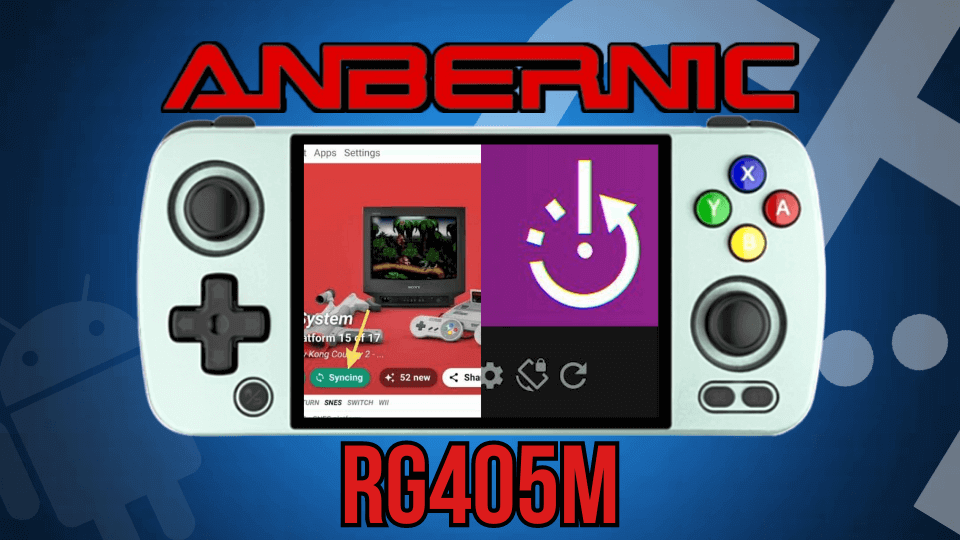Welcome to another edition of “It’s been another month, which means another Anbernic device is out!” Our esteemed guest for this foray into the fresh pool of devices is the Anbernic 405m, the latest and greatest that the company has to offer. Encased in a classy aluminum shell, this device exudes quality. The rounded edges, staggered analog sticks, and solid-looking buttons practically beg you to grasp onto it and never let go. The overall look resembles a typical Anbernic device but with enough change that you may have to do a double-take to make sure. The 405m is the next up to the plate after the surprising success of the 35xx, but shares little in common with the vertical, plastic handheld that captured our hearts just a short time ago. It boasts a stronger chipset, a bigger screen, a different operating system, a horizontal orientation, and analog sticks. It is, however, a solid entry into the Anbernic catalog, thanks to impressive performance and satisfactory ergonomics.
While there are plenty of reasons to celebrate this aluminum all-star, there are some downsides as well, perhaps more than one would imagine given all the unbridled praise I just gave the device in the last paragraph. Depending on your D-pad placement preferences, your favorite screen resolution, and your love or hate for Skittles (I’ll explain later), the 405m may or may not be for you. Is it the right size? Is the screen big enough? Does the metal get hot or cold like every single metal handheld does? I will attempt to answer the hard questions and the incredibly obvious ones to the best of my ability as we take this journey once again down the retro handheld rabbit hole. Hope you’re wearing your puffy blue dress on this very merry un-birthday because this tea party is going to take a bit.
Hardware

The Anbernic 405m reminds me of the 353m. It has a very similar overall style as the purple chocolate bar that housed Anbernic’s first set of hall-sensor analog sticks, with the placement of the left stick being one noticeable difference. The sea-foam green or black CNC aluminum shell stretches almost 6.5 inches across at the widest point, stands 3 inches tall, and is about 2/3 of an inch thick. In the center is a 4″ 640×480 resolution IPS display with fairly small black bezels and a remarkably clear glass lens. As per usual, the face buttons, D-pad, and analog sticks surround the glass rectangle and provide a balanced look to the front of the handheld. My initial thought when seeing the front actually made me think it was a bit crowded, as the buttons are pretty close together, but more on that in the Buttons section.
Start and Select sit quietly beneath the low-sitting right analog stick, while the classic 4-button layout sits directly above it – really close to it. The left side of the screen cascades down from the top analog stick to the D-pad and finally to the Home button nearest to the screen. You read that correctly, analog stick ON-TOP. I know this is a hot-button issue for some, but please, everybody calm down and let me continue my even-keeled review, dammit! Ok… where was I? Ah, the top! The upper edge from left to right houses in-line L1/L2, a cooling vent, a USB-C/DC port, a volume rocker, the power button, and R1/R2. The sides are devoid of any buttons or features. The lower edge contains the downward-firing speakers on one side, as well as a headphone jack and a micro-SD slightly to the right of center.
The aluminum itself has a smooth, luxurious feel and carries a bit of heft that adds to the “premier” experience that Anbernic seems to aim for with these metal shells. I have admitted in the past that I am not a huge fan of these types of shells…but dang…I can’t help but enjoy this one. The rounded sides and edges do not dig into your hand and the weight of the device is not so substantial that it becomes uncomfortable. The colors they chose look great (though I haven’t seen the black one in person, but hey, it’s black) and I’ll go ahead and say, this piece of hardware is sexy. Well, besides the Skittles part…
The Screen
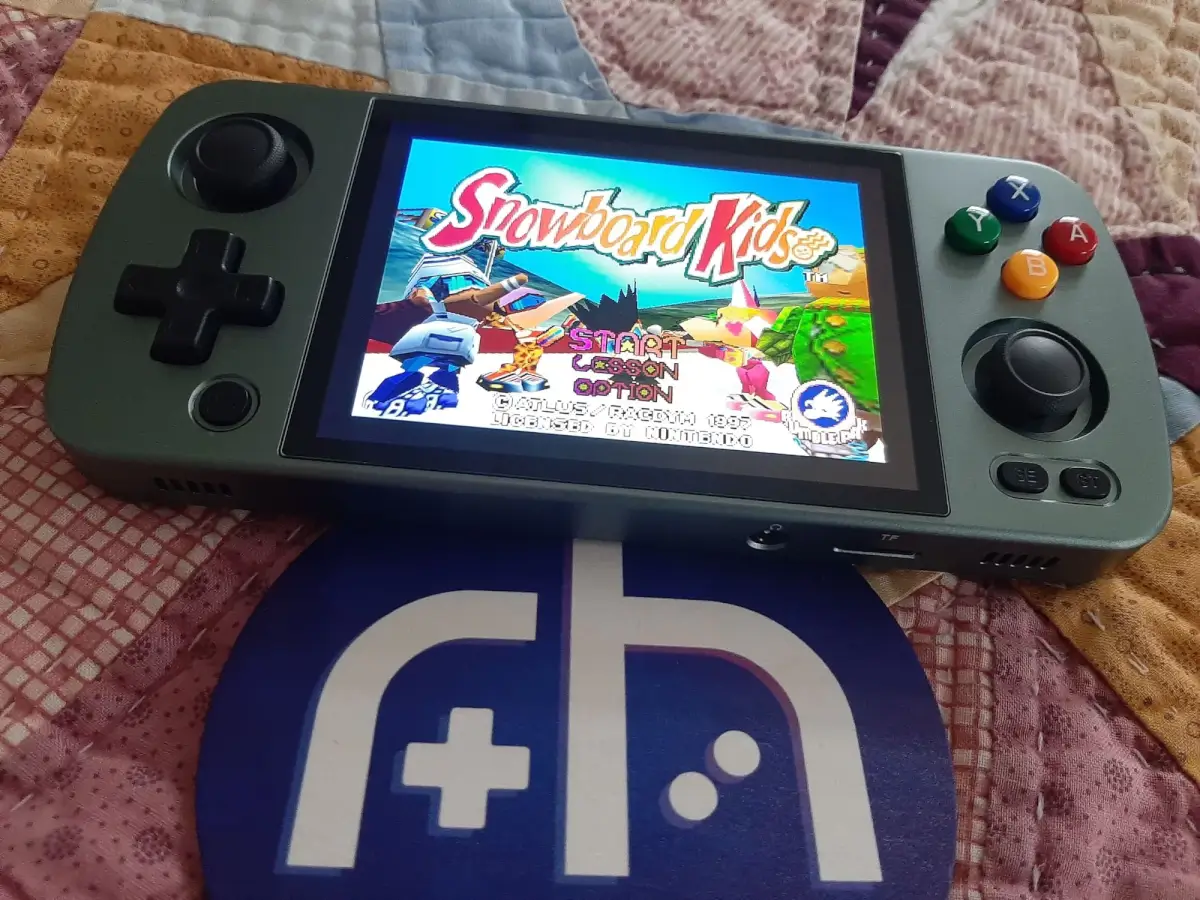
“Look at me! Hey I’m right here in the middle! I’m shiny and I light up!” – Pretty much every retro handheld around.
That quote sums up the majority of screens out there on the market now. To me there are so many great ones out there and the quality of even the low-tier stuff is high enough to provide a pleasant gaming experience. I personally have a hard time telling the difference between screens sometimes, I’m going to be honest with you. The 4 inch IPS screen on the 405m is something I struggled with evaluating. The 4:3 aspect ratio is great for retro games, aside from PSP games. It gets bright enough, but it’s fairly dim overall. In fact I generally run my Android devices at around 50% brightness and that is plenty, but on the 405m I had to set it closer to 75-80% to achieve the same level. While playing N64 games I found the screen an absolute stunner, meanwhile if I was streaming from Game Pass, I felt the screen was a bit blurry and simply not ideal for that particular use. The size is perfectly fine and I actually like that a screen being smaller than say, an RP3 can allow the device’s total stature to be a bit more compact. The only retro system that I tested that left me wishing for better quality was PSP. 640×480 is just not where that system thrives. I guess what I am trying to say is that this screen is somewhere in the middle of “it’s great” and “it could be better.” It would certainly not be considered top-tier, but I would say it resides above average. When something like N64 looks so crisp, bright, and colorful, it is difficult to knock it. On the flipside, despite the staggered analog sticks, I still would not use this much as a game streaming device. So I will not come out and say I love this screen but I certainly could not say I hate it either. If you are going to stick to mostly retro games (4:3 systems especially) then this screen is for you, as long as you are alright with a slightly low brightness.
The Buttons
So another Anbernic, another amazing set of buttons, right? Well yeah that is actually the long and short of it. Between the typical rubber membrane buttons, the responsive, clicky Start/Select/Home buttons and the comfy (albeit small), smooth-rotating sticks, the quality of the button using experience is top-notch on the 405m. The face buttons on my model are multicolored (SKITTLES!) and though they simply do not match the rest of the device in color scheme, they are a treat to use. Just enough of a “pop” when you depress and release them, a solid contact when they are pressed all the way down, and no wobble or shake when being left alone.
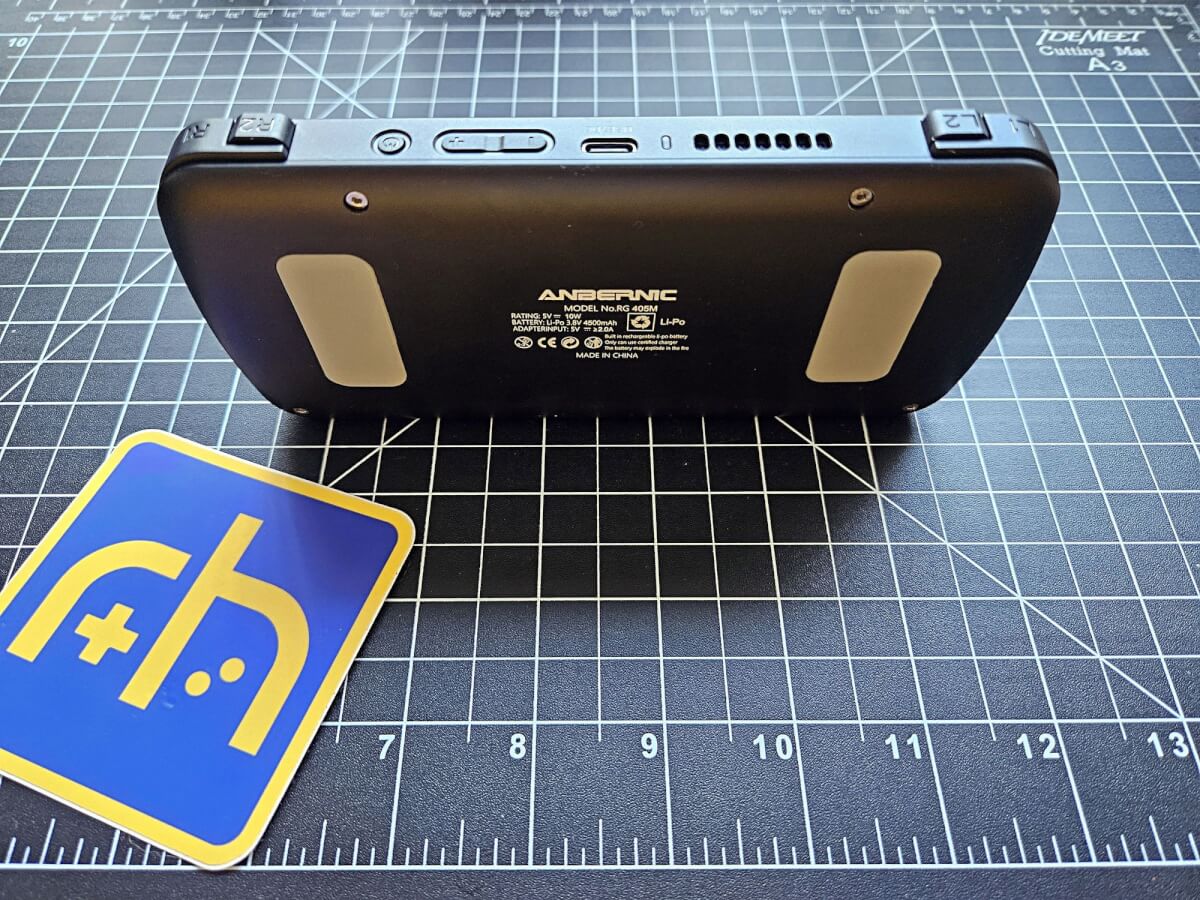
Moving on up we find ourselves gripping the trigger and shoulder buttons with our meaty little forefingers and it feels acceptable. The L2/R2 buttons are smaller but protrude a bit further out from the shell which makes for an easier time reaching and using them. A noble choice but still I prefer them stacked; that is just a reality of retro handhelds for me: stacked shoulders buttons are superior. Now I think most have us have heard the buzzy term thrown around lately when it comes to these devices: hall sticks, hall-sensor analog sticks precisely. If you have not heard of them, they use some sort of fairy magic, maybe it’s lasers? Actually, I think it’s magnets!! Anyway, they use magnets to sense inputs rather than components that physically touch and thus they do not wear out as quickly, which means less drift! Sweet, I know. The ones on this handheld have a nice bit of grip to them and they click to provide L3/R3 inputs. Their only downside for me is their size which is close to that of Switch Lite sticks and that to me is unfortunate because I have some fat-padded thumbs. They are recessed to the point of not hindering pocketability by much so that’s a plus. The buttons, as they are with most Anbernic devices I have used, are my favorite part of the handheld.
The Internals
Chips: we all love ‘em. Why wouldn’t we? I mean, we even have a mascot that centers on the crunchy snacks (shout-out to Steve). There is always talk around the RH water cooler about “what chip is best, which one is the strongest, which one is your favorite?” and I love it. So naturally everyone is curious about which chip is in the 405m. Well, it is a Unisoc T618 64-bit octa-core with 2 A75s running at 2.0GHz and 6 A55s at 2.0GHz. Do you know what that means? I do not have a solitary clue, but it sounds impressive. In terms that I can understand, it is a good enough chip to run things like GC and PS2 games so long as those games are not too hard to run. It is tried-and-true as it resides in the likes of the RP3+ and the PK X18s and at least the former of those two has been wildly successful.
A Mali G52 GPU makes an appearance while running at 850 MHz to process your graphics. That duo alongside another duo of 4GB of LPDDR4 RAM and 128GB of on-board storage makes for a solid internal package. You can purchase an SD card alongside the device, either 128GB or 256GB, and they will be loaded with games, but I prefer to use my own card, particularly on Android devices. Either way storage should not be a problem. As far as wireless connectivity we have both Bluetooth 5.0 and Wi-Fi in the picture, which is great any way you slice it. When it comes to sound, it comes out of those front-edge oriented speakers that we talked about earlier, which is acceptable. They send the sound in a good direction and it is sharp, clear. The one thing I did notice is that they do not get very loud. They do get loud enough, but if you are really looking to jam out to the amazing tracks in the DKC series on SNES, you may be a bit let down. Now onto my favorite part when it comes to the interior: the battery. The little juice box that brings power to all the goodies inside the shell. The one that belongs to the 405m is absolutely awesome. A 4500mAh li-po battery that has an estimated 7 hours of playing time and a 2 hour charging time; the battery life is exceptional. Of course this is boosted by the phenomenal sleep functionality of the OS, but any way I look at it, it’s the best part of the internals. I am a throw-a-device-in-my-pocket kind of person, and battery life is a big part of that, and the 405m shines in that arena. The heart of this device is strong.
Software
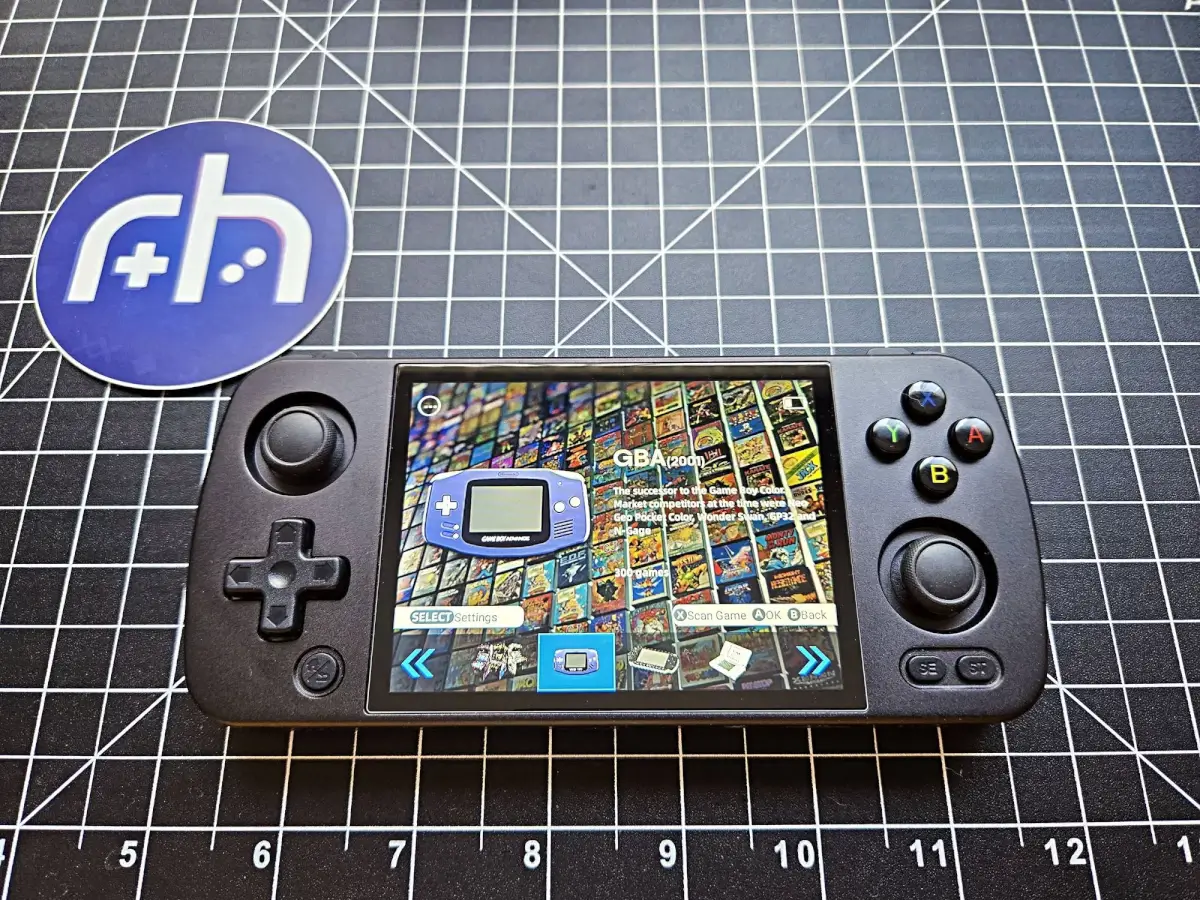
Android 12, heard of it? It is a sequel to the last big hit from Android: 11. Running the latest version of Android brings some great perks to Anbernic’s newest toy in the form of great battery life, native android gaming, and as previously mentioned a seamless sleep function. If you can stand the setup required for an Android gaming device the positives really do shine. The ease of access when it comes to Google Play apps, Moonlight, Game Pass, etc… is something that can certainly entice someone into using a handheld over another. The Game Pass experience is a bit hindered by the screen as I said, but other than that the process of actually using and navigating the application is a simple one. If you are familiar with Android then you are familiar with this. I always suggest using a front-end when running Android in order to launch and organize your game collection, and Anbernic has one of their own included. I find it usable. If you have not used or set up a frontend before I actually think this one is the one to use. It’s simple, effective, and already installed. On the other hand, I do not think it is the best front-end out there (cough Daijisho cough) as it is a bit clunky and the look is very basic and uninspired, but it’s a viable option.
Access to the Google Play store is built in and allows for flexibility when it comes to downloading apps and running things off of your Google account. There is a key mapper included with this Android build, but I have to say, it is not the easiest to understand and I got my buttons all messed up real quick and had to restart the device in order to reset them. It was nice to have when I played an Android game, but I dislike the way it is implemented. If you are a fan of the Android OS then I think this device will fit nicely into your arsenal. Of course, there is no option for dual-booting thanks to the missing second SD card slot that so many Anbernic devices have had, and that is unfortunate if that is a feature you enjoy.
Game Testing
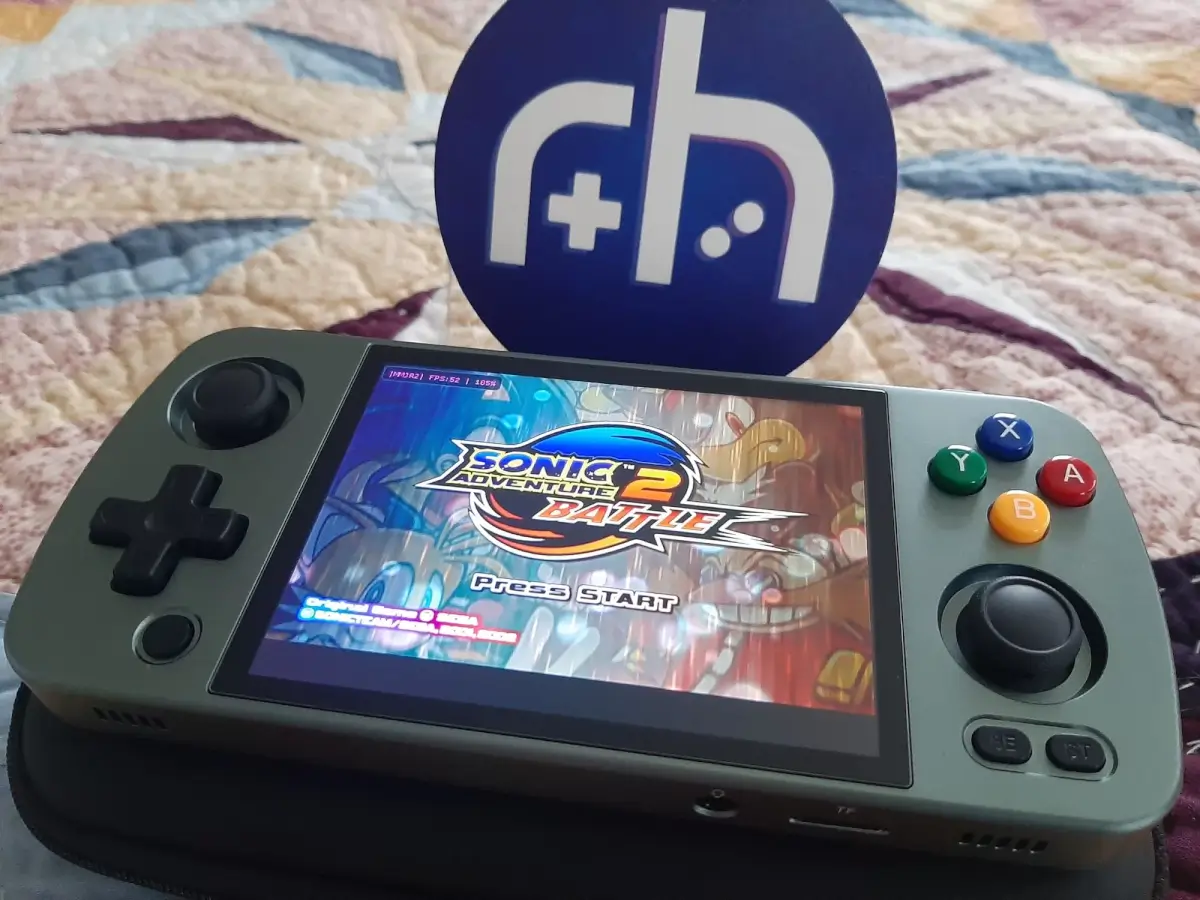
Finally, the section where we talk about what this thing can play! If any of you skipped down to this section without reading the rest… shame on you. Eh, who am I kidding? I just appreciate that you showed up at all! However, you arrived here I am glad that you did. Within the emulation capabilities of the 405m there lies a large variety of systems, but I know many of you just want to know the ceiling rather than the floor, or the cabinets, or the counters. At the tippy-top of the list we find GC and PS2. That’s it, no higher; and even at that peak, only a certain amount of those games will be playable at a sufficient level. Games from GBA and under are flawless even with upscaling and filters. DC games perform extremely well. Where I think the performance and screen combination really shine is with N64 games. Playing Snowboard Kids was an absolute delight while looking incredibly good. I was impressed the second I fired it up. The stick-centric layout makes the controls a good fit for N64 (a tough feat to accomplish) and I can say that it was my favorite system to test. Now we head upward and if you can believe it, the journey to the top was actually a pleasant surprise. I did not expect to be able to play many GC/PS2 games enjoyably and well…I was not able to play MANY.
However my go-to GC tester game is Sonic Adventure 2: Battle and I have to say that with a little tweaking and the help of the included Dolphin MMJR2 emulator that game ran very well. Not perfect, and yeah it was the PAL version, but I was able to hit 50fps for around 70% of the time I played. The experience with GC and PS2 is going to be like that: try a game, try some tweaks, try some different emulators, and just hope for the best. The one system that actually let me down the most compared to my expectations was PSP. The screen just is not built for it. The performance is there thankfully, and the analog stick again made the controls a joy, but it just does not feel great playing on the screen. With that said, if you do not have another device on which to play PSP games then this will indeed suffice. Game testing was a pleasure with the 405m, I’m not going to lie. I think the performance is a huge upside and the main reason people should get the device…unless they already have a T618. In that case, I say it would be the buttons.
| Fully Playable |
|---|
| Atari 2600, Atari 5600, Atari 7800 |
| Nintendo Entertainment System |
| Super Nintendo Entertainment System |
| Nintendo Game Boy |
| Nintendo Game Boy Color |
| Nintendo Game Boy Advance |
| Nintendo Virtual Boy |
| Nintendo 64 |
| Nintendo DS |
| Sega Master System |
| Sega Genesis / Mega Drive |
| Sega 32X |
| Sega CD |
| Neo Geo Pocket |
| Neo Geo Pocket Color |
| Sony PlayStation |
| Sega Saturn |
| Sega Dreamcast |
| Sony PlayStation Portable |
| Mostly Playable |
| Oops? No, this section is empty on purpose. |
| Somewhat Playable |
| Sony PlayStation 2 |
| Nintendo GameCube |
| Nintendo 3DS |
| Out of Reach |
| Nintendo Wii |
| Microsoft Xbox |
| Sony Playstation 3 |
Where to Buy
AliExpress
Anbernic Official
Amazon
Average Price
$170-190
Delicious:
- The rounded sides, as they add to the comfort AND the pocketability.
- Amazing buttons, VERY pushable.
- Performance is great for something of its size.
- Battery life is soooooooo good.
- Hall-sensor analog sticks are great and ease the worry of stick drift over time.
- Aspect ratio is great for many retro systems.
Suspicious:
- In-line shoulder buttons are second-tier.
- Only two color options and both are a bit underwhelming (the green-gray looks amazing, but those buttons are questionable at best.
- No HDMI out… which I did not mention before but yes it is unfortunate.
- The price may be a bit steep for some people.
- No plastic variant as of yet.
Final Thoughts:
- When I heard about a new metal Anbernic device headed down the pipe I honestly could not have been bothered to keep up with news on it. I was not excited for its arrival as I was content with my RP3+ and the performance that it offered, and I figured the price on the 405m would render it out of my price range for an impulse buy. So when the aluminum handheld showed up for review, I was a bit skeptical and unsure how I would feel about it. Little did I know that the shape and pocketability of it would win me over so quickly. The shell and shape in tandem with the superb button quality (great Skittles), overall performance and OS experience create a remarkably unique and quality package.I found myself surprised both pleasantly and unpleasantly by some things. The screen let me down for a reason I did not expect: rather than the size, it is the brightness and resolution when it comes to game streaming or certain systems. The battery is a VERY welcome surprise as the life is longer than a cross-country road trip to somewhere you don’t want to go. The hall-sticks feel great but the caps are a bit on the small side like almost every other handheld made in the last year or two. However my final thoughts on this sturdy handheld can be summed up rather easily: the pocketability and performance alone make this device worth owning for me. Throw in the buttons, the sticks, and the battery, and keeping this as a member of my collection is a no-brainer. If you have the cash and do not have a T618 device, this one is absolutely worthy of a purchase. Just remember that no device is perfect, and the Anbernic 405m is no exception.
(This review has been written and provided by Rocketman824)
